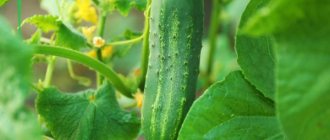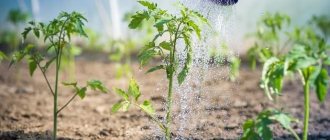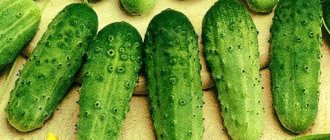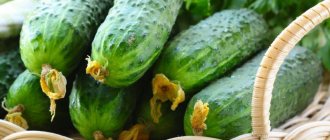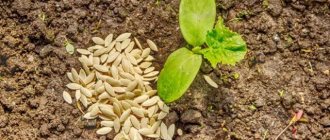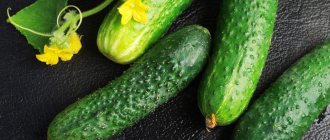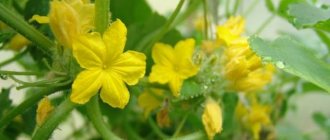Of the huge variety of different varieties of cucumbers that various companies currently offer us, it is quite difficult to navigate without having any information about a particular variety. Even if you risk an experiment, you would still like to get at least a minimum of knowledge about what you are going to grow. In this article we want to tell you about a wonderful hybrid - the Dutch “Mirabell F1”, which managed to win the love of a huge number of gardeners and gardeners.
Description and characteristics of the variety Mirabella F1
Mirabella cucumbers are a hybrid variety developed by Dutch breeders. Before sowing a crop, pay attention to the description of the bush, fruits and yield characteristics.
Did you know? The name of the plant "cucumber" comes from the word
"ogouros" from the Byzantine Greek language and translates as "unripe".
Appearance of the bush
The bushes are classified as medium-sized. The stem grows up to 5 m in length. The leaves are dark green and medium in size. Flowering occurs according to the female type. The ovaries are formed in a bouquet; up to 8 fruits are tied in one bosom. The Mirabella F1 variety belongs to the gherkin variety.
Cucumbers are cylindrical in shape and grow up to 15 cm in length. The average diameter of one fruit is 3-4 cm. The weight of one vegetable ranges from 90–100 g. The peel is emerald in color with small light stripes. Cucumbers have a large number of tubercles and black thorns.
Taste qualities of cucumbers
Tasters note the high taste qualities of the fruit. The flesh is crispy, not watery. In most cases there is no bitterness.
Fruitfulness
Hybrid Mirabella is characterized by high yield. From 1 m² of plantings, gardeners harvest 20–24 kg of fruit. The marketable yield of Mirabela F1 cucumbers is 7-8 kg.
Find out what to feed cucumbers during flowering and fruiting.
Ripening and flowering dates
With timely planting, budding begins in June. The fruits ripen early, technical ripeness occurs 40–45 days after the appearance of the first shoots.
Reviews
- Konstantin Evgenievich, 39 years old: This year my wife and I bought a dacha. I planted Mirabella cucumbers. I really liked the resulting harvest. Cucumbers were collected until autumn. Care is very simple and does not require any specific skills. The fruits are tasty and aromatic, there is no bitter taste.
- Elena I., 42 years old: I have been growing the Mirabella variety for several years in a row. I'm happy with everything. The yield is high, the fruits are high quality, my children ate them straight from the garden. The taste is sweetish, no bitterness. I applied fertilizing regularly and did not tie up the bushes, but this did not prevent me from getting a huge amount of excellent fruits. I made preparations for the winter.
cucumber Mama's favorite F1 - description and characteristics of the variety
The Mirabella F1 variety has long become popular among Russian farmers. Due to its high yield, it is often grown on an industrial scale. Our farmers choose this particular variety for canning and preparing pickles. Many of them are happy to share their feedback and growing experiences.
Variety Mirabella F1 is a cucumber hybrid that does not require intensive care. It bears good fruit and tastes like vegetables. Resistant to many diseases.
Pros and cons of the variety
A hybrid has its pros and cons.
- Among the undoubted advantages of the Mirabella variety:
- early maturation;
- the ability to grow vegetables in a greenhouse and garden;
- no need for pollinators;
- 99% germination;
- low maintenance requirements;
- keeping quality;
- transportability;
- resistance to most diseases;
- high yield.
- However, the culture also has several disadvantages:
- in the north only greenhouse cultivation is possible;
- low resistance to cold;
- lack of immunity to a number of pests;
- demands on bush formation.
The main difference from other varieties is that Mirabella cucumbers are gherkin cucumbers - the fruits grow small in size. At the same time, high productivity is noted. The hybrid is parthenocarpic, which allows the plants to self-pollinate and set fruit.
Conclusions about the popular variety of Mirabella cucumbers
Thus, Mirabella cucumbers are quite in demand among farmers today. This hybrid form has a lot of positive features. The culture is not capricious in cultivation, produces a stable and abundant harvest, which can be stored for a long time and is suitable for transportation. To achieve great success in growing Mirabell, experts advise following agricultural techniques, planting seedlings correctly and properly caring for the bush. See the article: When to plant cucumbers as seedlings at home and in the ground in the garden?
Features of sowing and growing
Mirabella F1 cucumbers can be grown in a greenhouse or in open ground. Regardless of the planting method, seedlings are first grown. Seeds for seedlings are sown in early April.
Important! In northern latitudes, the greenhouse growing method is preferred. In the middle zone and in the south, planting in the garden is allowed.
The process of growing seedlings is as follows:
- Soak the seeds in water.
- Prepare peat cups.
- When sprouts appear from the seeds, transfer the material to peat cups.
- Keep the crops in a room with a temperature of +22…+28°C.
- Periodically moisten the soil with a spray bottle, the frequency depends on the speed of drying of the substrate.
25–30 days after the first shoots appear, the seedlings will have 3-4 true leaves. At this point, it can be transplanted into a greenhouse or garden. The approximate time for transplantation is mid-May.
In the open ground
When planting in open ground, choose sunlit areas. The area must be protected from the wind. Also make sure that the soil has had time to warm up to +15°C. The timing of transplanting seedlings can be postponed if cold weather is expected.
Scheme for transplanting seedlings to a permanent place:
- Dig the soil halfway up the spade.
- Dig holes using a pattern of 0.4 m between rows and 0.2 m between plants.
- Moisten the potted seedlings.
- Carefully remove the seedlings from the pots along with the earthen ball.
- Without shaking off the soil from the root system, move the seedlings to a permanent location.
- Fill the free space in the holes with soil.
- Water the plants.
Cucumber planting scheme.
Planting in a greenhouse
Before planting seedlings in a greenhouse, make sure that the daytime temperature is +25...+28°C, and the soil temperature is +14...+16°C. Humidity should be 60–70%. It is also advisable to install a ventilation system, otherwise the greenhouse will need to be ventilated daily.
Useful tips
Vegetable garden plots and crops on them are subject to infections and insect attacks. The lion's share of diseases and pests will be avoided by:
- Digging the soil in the fall, mixing it with compost or rotted manure.
- By alternating the places where vegetables are planted, for example, by planting tomatoes instead of cucumbers and vice versa.
- Disinfection of the greenhouse premises with a sulfur bomb. To do this, set it on fire and leave it for a day, while closing the doors and windows. After time has passed, the greenhouse is ventilated.
- Treating working tools with alcohol or other disinfection methods.
- Timely weed removal.
- Burning old plants after harvesting at the end of the season.
As practice shows, parasitic insects cannot tolerate high humidity, so it is worth taking care of its level in the greenhouse. To do this, it is enough to place a container with water, which will also compensate for sudden temperature changes.
Features of care
To obtain a high-quality harvest, it is important to properly care for the plantings. Pay attention to watering, fertilizing, tying, bush formation and soil care measures.
Frequency of irrigation and fertilization
Watering is carried out as the soil dries out. Moisture should not stagnate in the soil, but the substrate should not be allowed to dry out. During hot weather, plantings can be watered daily. It is necessary to moisten the soil with water at a temperature of +24…+25°C. The best time for irrigation is morning or evening.
Fertilizing is carried out four times during the growing season:
- 2 weeks after sowing;
- during the budding period;
- at the beginning of fruiting;
- after harvesting the first batch of fruits.
The variety responds well to organic matter.
Important! When fertilizing the bushes, do not exceed the specified doses of fertilizing. Excessive feeding often leads to disturbances in plant development.
For fertilizer, agronomists advise using the following options:
- cow manure solution (1 kg per 6 liters of water);
- infusion of chicken manure (600 g per bucket of water);
- slurry (1 kg per 8 liters of water).
Garter and bush formation
The bush is formed into one stem. The cutting pattern is as follows:
- side shoots are grown from the soil level to a height of 0.5 m;
- at a level of 0.5–0.8 m (5-6 leaves), shoots from the axils are shortened to 20 cm, the tops are pinched;
- at a level of 0.8–1 m, the shoots are shortened to 30–40 cm, the tops are pinched;
- at a level above 1 m, the shoots are shortened to 40–50 cm.
The lashes must be tied to the trellis as they grow.
Soil care
Soil care consists of several simple operations:
- Loosening . The soil is fluffed up after each moistening. If the soil is not loosened, it will form a crust, which will prevent the root system from being saturated with oxygen.
- Weeding . Weeds are pulled out as they grow. It is most convenient to carry out weeding immediately after loosening.
- Mulching . In order for the substrate to better retain moisture, the soil around the stems is covered with organic mulch - sawdust, hay or straw.
Did you know? Employees of a breeding station in the United Arab Emirates bred cube-shaped cucumbers. Such vegetables are convenient to store and transport. The taste remained unchanged.
Landing
Since Mirabella F1 is a parthenocarpic plant, seeds cannot be collected from it for subsequent planting. Seed material is purchased in specialized stores. Growing cucumbers is possible in two ways: without seedlings and seedlings. For planting crops, choose sunny areas that are protected from strong winds. Mirabella F1 does not tolerate cold well, so it is planted only after the soil has warmed to +15 °C, when the threat of night frosts has subsided. Usually this time occurs in the second half of May. The soil on the site should be light and fertile. Since autumn, rotted manure has been added to it. To disinfect the soil, it is watered with a weak solution of potassium permanganate. The seeds are buried in the ground by about 2 cm. At the same time, make sure that the distance between plants is 40 cm, and the row spacing is 20 cm.
May be interesting Black currant - characteristics of large-fruited varieties Potato variety Molly: description and characteristics, reviews Advantages and disadvantages of the cucumber hybrid "Merchant f1"
The seedling growing method is more labor-intensive, but it allows you to get an earlier harvest. It involves planting seeds in separate containers (for example, peat pots). After about a month, the seedlings are transplanted to a permanent place. For the first time, it is covered with caps (for this, 5-liter bottles are cut in half). They protect against cold snaps at night and prevent the rapid evaporation of moisture. After the seedlings take root, the caps are removed.
The soil for growing seedlings is prepared in advance. To do this, ordinary soil is mixed with peat or humus. To ensure that seedlings appear earlier, the crops are placed in a warm, well-lit place. If necessary, hang a lamp above them. After about a month, the seedlings are moved to a permanent place. A week before transplanting, the seedlings begin to harden by taking them out into the open air for several hours every day.
Prevention and control of diseases and pests
The variety is resistant to most diseases; At the same time, one should be wary of pest attacks.
According to reviews from gardeners, Mirabella cucumbers most often amaze:
- thin tick;
- thrips;
- aphid.
To combat these pests, use the drug "Actellik" from. When grown in open ground, the product is used twice with a break of 20 days. In greenhouses, cucumbers are processed three times, the waiting period is 3 days.
Advantages and disadvantages
Pros:
- precocity;
- strong immunity to VOM, MR, cladosporiosis;
- good germination (within 91-100%);
- excellent pickling and canning properties;
- pleasant taste without bitterness;
- versatility of cultivation and use;
- tolerance to sudden temperature changes;
- good transportation and keeping quality.
Minuses:
- below average resistance to rust;
- cucumber is not resistant enough to return frosts.
Harvest and storage
When the fruits begin to ripen, they are harvested every 3-4 days. During mass fruiting, the crop is harvested daily, without leaving it on the bush for long. The use of cucumbers is universal. The fruits are suitable for pickling, pickling and fermenting. If you plan to eat it fresh, the harvest should be stored in the vegetable section of the refrigerator for no more than 7 days.
Find out how to make cucumbers without sterilization in your own juice.
High yield, excellent taste and disease resistance justify the high rating of the Mirabella F1 hybrid. With proper cultivation, timely watering, fertilizing, bush formation and pest prevention, the gardener is guaranteed to get excellent results.
How to grow Mirabella and under what conditions?
Experienced agronomists know what cucumbers like to grow and what conditions this crop needs. Therefore, they manage to achieve great success in cultivating Mirabell. Although the hybrid is unpretentious, it is better to avoid mistakes and care for the plant correctly.
Here's how to properly plant cucumbers in a polycarbonate or glass greenhouse:
- The soil must be warmed to a level not lower than +15 degrees.
- It is important to prepare the soil before planting. It is necessary to use high-quality, fertile soil.
- The seedlings are planted in the greenhouse a month after germination. If the greenhouse is unheated, planting is carried out no earlier than the second week of May.
- First, the holes are watered with a weak manganese solution.
- Young plants are transported along with a clod of earth.
- Sprinkle with earth.
- It is required to maintain the distance between cucumbers in the greenhouse when planting: seedlings are planted in a row every 20 centimeters, rows are placed at a width of 40 centimeters.
